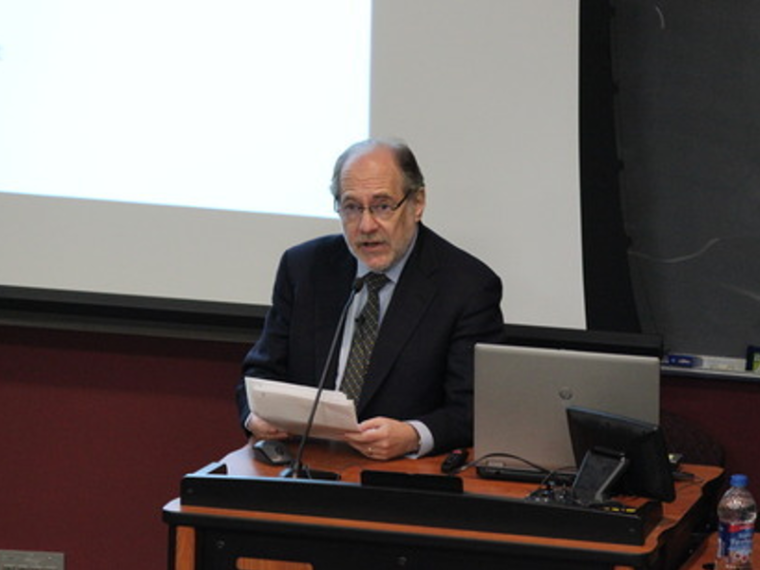Critic and Author Gary Giddins Visits Oberlin for "Picturing Jazz" Talk
November 28, 2014
Conservatory Communications Staff

“There are some writers so prodigious in their output that one suspects that they are actually a whole team of people all creating work under the same pen name. Gary Giddins is one of those writers,” Jeremy Smith, special collections librarian and curator of Oberlin's James and Susan Neumann Jazz Collection, said in introducing Giddins to a packed lecture hall on November 20. The renowned jazz critic and author has “won so many ASCAP-Deems Taylor Awards that they considered renaming the prize the Gary Giddins award,” Smith quipped.
Giddins was in Oberlin to give the Harold Jantz Memorial Lecture on the theme “Picturing Jazz: Jazz and Photography.” Giddins is a fascinating speaker, both in lecture and in conversation. He is a vast repository of knowledge and is more than willing to dispense that information in an accessible, witty manner.
He began his lecture by defending photography as an art form and then talked his way through a trove of photos, positioning “the photographer or portraitist as mythmaker.” In the course of discussing both famous and lesser known photos, he praised jazz for its casual racial integration (“people were afraid of the music because they thought it would bring white and black together, and they were right!”) and related inspiring and fascinating stories about the musicians depicted. The talk more than illustrated his thesis that “photography can enhance your listening and capture a musician better than anything other than a biography.”
During an hour and a half breakfast with six students, Giddins commented on editors, lamented the lack of comprehensive biographies of major jazz musicians, analyzed vocalists from Sinatra to Ella Fitzgerald, recommended songs, books, and documentaries, and explained the development of bebop. He also diagnosed what he perceives as the reasons that jazz suffers from widespread ignorance: race, a tendency to semantically denigrate the music with nonsense labels like bebop, and a lack of exposure to it in schools.
Giddins also recognized Oberlin's own incredible resources. With the recent addition of the papers of legendary bassist Milt Hinton to the already massive Neumann Jazz Collection, he believes that “Oberlin has the potential to be one of the greatest jazz archives in the world.”
Tags:
You may also like…
Contemporary Collaborations with Third Coast Percussion
April 15, 2025
“Strum,” “Strike,” and “Bend” are all evocative references to the physicality of string and percussion instruments. And one is especially significant.
Martha Redbone Hears Her Musical Call
March 18, 2025
The vocalist and songwriter brings her distinct blend of folk, blues, gospel, and more to Finney Chapel on April 6 in an appearance with the Martha Redbone Roots Project.
Oberlin Opera Brings “Jack and the Beanstalk” to Schools Across Northeast Ohio for Winter Term
March 10, 2025
“It was really amazing going into the community and performing an art form that they probably haven't seen before,” second-year voice major Ella Vaugn said, “Teachers would tell us that they've never seen their students so engaged.”


